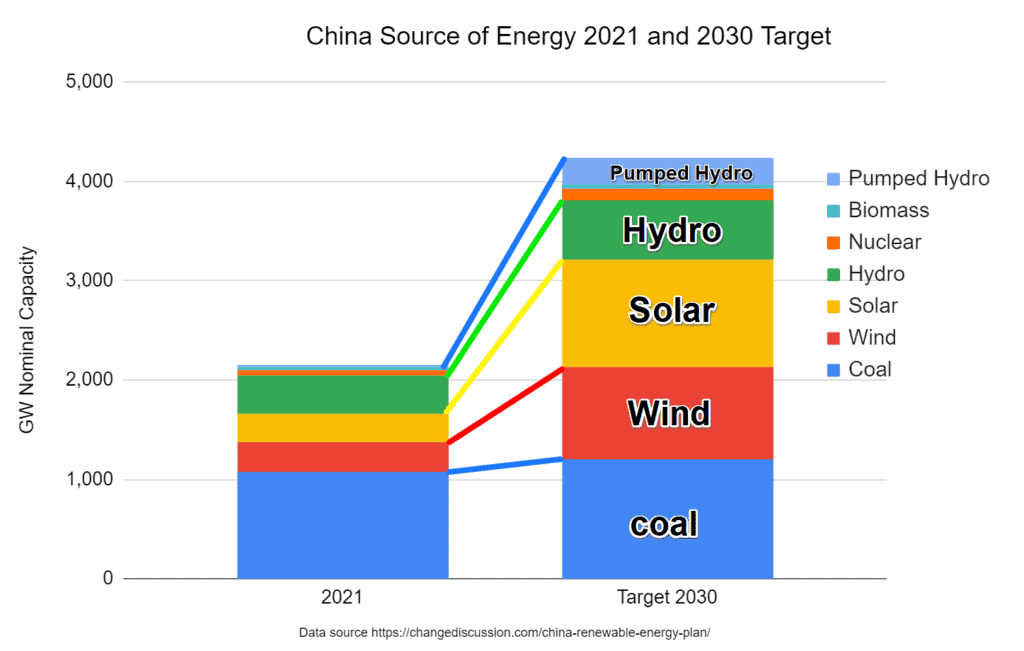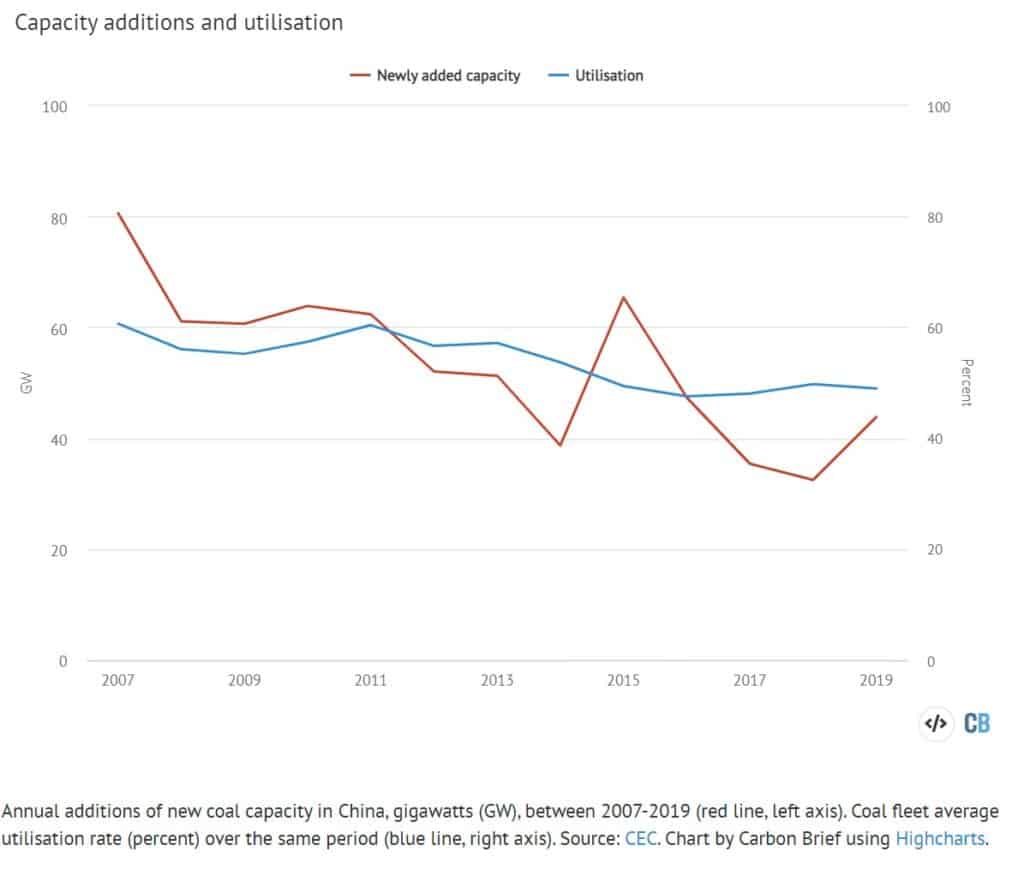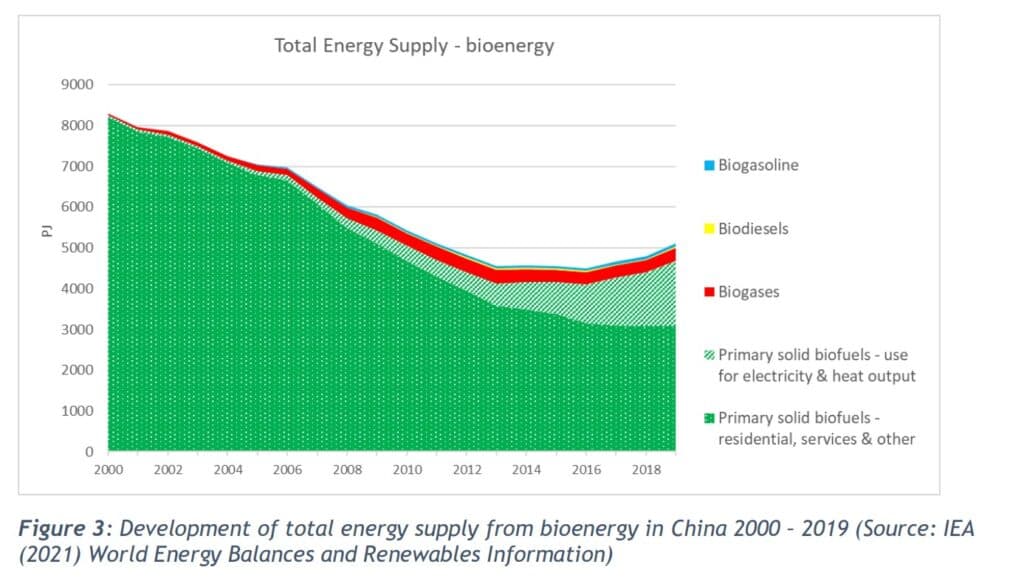We often hear that China is still building coal fire power stations or going nuclear but the fact is that in 2022 the plan is a China Renewable Energy Plan, not a change to fossil fuel or nuclear. Every measure and communication is the bulk of new energy is renewable. Every week in 2022, China is building renewable energy more than a coal fire power station or over 110GW per year. China has a shortage of energy for its economy with many still in energy poverty and poverty (energy or food) is not good for political stability. China’s priority is all new energy generation will be renewable or low emission within 4 years so are building as much nuclear, wind and solar as they can. They are phasing out fossil fuel industry subsidies and a heavy reliance on coal are countered by government policies requiring investment in renewable energy.

| Source of Energy | 2021 | Target 2030 | Change % |
|---|---|---|---|
| Coal | 1,080 | 1,200 | 11% |
| Wind | 299 | 930 | 211% |
| Solar | 282 | 1,082 | 284% |
| Hydro | 385 | 600 | 56% |
| Nuclear | 55 | 119 | 116% |
| Biomass | 35 | 35 | 0% |
| Pumped Hydro | 15 | 270 | 1700% |
The China renewable energy plan is for Net Zero
China has a goal to reduce Carbon Emissions to net zero by 2060. China is the 2nd largest carbon emitter behind USA and its target of net-zero by 2060 considers the large amount of energy it has from coal that needs replacement. China’s revised NDC is equivalent to a 68.3% cut in the country’s CO2 intensity by 2030. (Carbon Brief). Various studies suggest that China has the potential to overachieve against its climate commitments. This reflects an important difference between China and some other countries, when it comes to making international pledges as the CCP does not need to go back to the people and get approval as the CCP is the ultimate control.
Details of China’s Renewable Energy Plan
| Source of Power Generation | 2021 | New in 2021 | Expected 2022 | Target 2030 |
|---|---|---|---|---|
| Coal (Cargon Brief) 2990 stations | 1,080 GW | 33GW | Approval for 8GW in Q1 | 45% of Mix 140GW of New |
| Wind | 299GW | 26GW (7.5% of power) | 35GW | * About 75GW per year |
| Solar | 282GW | 54.94GW in 2021 forecast 108GW in 2022 | 100GW | * 25GW (Adding 100GW of solar & wind pa) |
| Hydro | 385GW | 16GW | Potential of 600GW | |
| Nuclear | 55GW | 55GW | 70GW by 2025 120GW | |
| Biomass | 35GW | |||
| Batteries (Pumped Hydro) | 15GW | 4GW | Start on 270GW | 270GW |
- China’s demand for energy has grown 287% since 1990 – see image below Source https://www.iea.org/countries/china and the current energy mix is
- The CCP has stated that within 3 years, renewable energy is expected to meet more than 70% of China’s “additional” electricity demand – which stands for any increase from today’s level (IEA Electricity Market Report – January 2022)
- Currently solar power capacity is 306 GW, with a record 54.9 GW added just last year.
- China is planning to expand its offshore wind capacity in the coming years. I
- Solar and wind now account for 635 GW of power, making up 26.7% of China’s total national capacity.
Emissions Over 20 Years

Wind Energy
Wind energy systems in China built 47.6GW of wind in 2021 and is targeting an additional 110GW in 2022. China built more offshore wind in 2021 than had been built in every country over the past 5 years (Forbes)
- The first Chinese wind farm was located in Rongcheng of Shandong Province in the northeast of China; by the end of 2003, 40 wind farms were operating nationwide
- The largest wind farms are located in Dabancheng of Xinjiang Province, Nan’ao of Guangdong, Donggang of Liaoning, and Huitengxile of Inner Mongolia.
- Onshore wind is the conventional technology. Land and social issues is changing the focus to offshore.
- Onshore wind is not where the major population is; so a major change is to move to offshore wind closer to population and industry centers.
- Offshore wind installed capacity of offshore wind is over 26.4GW and in 2021 there was 17GW offshore installed, which mean it doubled in 2021. It is 2.5 times that of the previous world leader, the UK.
Solar Energy
Distributed solar is rapidly increasing. A report by The State Council says
- 16.88 GW of solar capacity was deployed between January and April 2022, a growth of almost 130% year-over-year (YoY).
- During the same period, 45 GW of modules were exported, accounting for almost half of last year’s export volume.
- The top five module manufacturers are aiming at a combined shipment of 183 GW-205 GW in 2022, increasing 46-64% YoY.
- Those top five could potentially meet nearly 80% of this year’s global demand.
- The State Council news June 2022 reported that China launched its first phase comprising 100GW gigawatt total wind and solar power capacity in the desert areas by the end of 2021, which covers 19 provinces nationwide.
- A statement jointly released by the National Development and Reform Commission, China’s top economic regulator, and the National Energy Administration at the end of May
- The country will increase its total installed capacity of wind and solar power to over 1,200 GW by 2030
- Cover as many as 50 percent of the nation’s buildings with rooftop solar panels.
- China is building out its solar power capacity.
- By the end of 2021 solar reached 306 GW
- A record 54.9 GW added in 2021
- China’s National Energy Administration (NEA) has announced that out of the 121 GW of solar projects under construction, nearly 108 GW of new solar capacity will be connected to the grid by 2022. The number put forward by NEA is nearly double the 54.94 GW solar capacity additions last year
Nuclear Energy
- Nuclear energy accounts for 2% of the nation’s power generating capacity, with just 5% of overall electricity output last year.
- China had 53 nuclear power plants at the end of 2021
- Total generating capacity of about 55 gigawatts
- Planned expansion to 70 GW by 2025.
- Longer-term capacity is planned to double to 120 GW to 150 GW by 2030
- Three nuclear power plants in coastal provinces will each receive two new reactors
- Construction costs are estimated at 120 billion yuan ($18.7 billion) for all six reactors combined
- Source: China greenlights 6 new nuclear reactors in shift away from coal
Coal and Gas
There are varying reports of coal expansion out of China and hard to get the real truth. Global and internal politics can change overnight (e.g Ukraine). The State Grid Corp of China has said 150GW will be deployed by 2026 when coal consumption has to decrease, yet other reports (PowerMag) say at least 15 coal plants were cancelled and another 37 GW in limbo (see politics).
- A paper in Nature Communications found 186 out of China’s 1,037 active coal plants are – from a technical, economic and environmental perspective – performing poorly and are “particularly suitable” for fast-track retirement.
- Carbon Tracker estimated in 2020 that the average coal fleet loss was about $4/MWh and that about 60% of power stations were cashflow negative in 2018 and 2019.
- Check out the graph of additions below.
- Meeting net zero by 2060, means coal’s share of the energy mix dropping significantly from 57% in 2020 to 51% in 2025 and 45% in 2030, (Carbon Brief study from Tsinghua ICCSD)
- NDRC researcher forecasts 140 gigawatts of new capacity although some of the coal is replacement of old coal plants.
- Reuters says that in 2021, China started building out 33GW – the most since 2016. New permits were suspended in 2021, but resumed in 2022, with five projects with a total capacity of 7.3 GW approved for construction in the first six weeks of the year.
- Analysts suggest China could have an additional $90 billion to $130 billion in stranded assets.
- Note that China will start cutting coal consumption from 2026, but is likely to put an additional 150 GW of coal-fired power into operation before then say researchers with the State Grid Corp of China.
Hydro Power
- China’s hydropower capacity is more than three times that of any other nation at 356GW in 2019 (1,302 TWh)
- Hydropower accounted for roughly 18% of China’s electricity generation and 19% of China’s installed power capacity.
- China installed 8 GW of new hydropower capacity in 2019, and 4.2GW in 2020.
- Hydro has displaced huge numbers of people from fertile valleys.
- Other renewable energy sources are now cheaper.
Pumped Hydro And Batteries
- Most research suggests that 20% to 30% of storage is needed for renewable energy. China has nuclear and hydro.
- China has a large battery production ecosystem with gigafactories announced widely for their EV Production
- China will start construction on more than 200 pumped hydro stations with a combined capacity of 270GW by 2025 and reported in the Straits Time.
- Thats more than the capacity of all the power plants in Japan, and would meet about 23 per cent of China’s peak demand.
- China has been eyeing a major pumped hydro build-out since 2020. In early 2021, they stated 680GW with a possibility of 180 gigawatts by 2025
- Most recent of policy (late 2021) said 65 GW by 2025, and 120GW of capacity by 2030.
- Increased 4 times to 275GW by 2025.
Biomass
- The National Development and Reform Commission, the Ministry of Finance, and the National Energy Administration have researched and formulated the “2021 Biomass Power Generation Project Construction Work Plan” (IEA Announcement here).
- The Govt has planned $370m (2.5 billion CNY) subsidy for biomass power generation in 2021.
- Biogas has stabilised around 300 PJ, which is 16.6% of bioenergy.
- Most is used to supply gas to residents for cooking and electricity production and is being mostly replaced by oil and gas.
- Transport biofuels (predominantly bioethanol) represent 7.2% of bioenergy in China.
- Modern use of biomass for power and/or heat production and biogas is growing (see graph below)
China Political System
China’s Politburo – known in full as the Central Political Bureau of the Communist Party of China – is the supreme decision-making body of the party and currently has 25 members. China’s president Xi Jinping addressed his top officials about the nation’s carbon peaking and carbon-neutrality drive ” developing light energy, silicon energy, hydrogen energy and renewable energy actively and orderly”.
Provinces have their own development projects and there are much coal fired power stations that have been built with CCP money and are sitting idle. Part of the challenge of politics and energy production and energy use is the conflict between what the province decides and its differences from the CCP.








Further Reading On the China Renewable Energy Plan
- https://www.carbonbrief.org/analysis-will-china-build-hundreds-of-new-coal-plants-in-the-2020s/
- https://www.scmp.com/business/china-business/article/3161732/china-remain-renewable-energy-leader-strong-capacity-growth
- https://www.reuters.com/markets/commodities/china-starts-building-33-gw-coal-power-2021-most-since-2016-research-2022-02-24
- https://www.powermag.com/at-least-15-china-backed-coal-plants-canceled-another-37-gw-in-limbo/
- https://www.carbonbrief.org/china-briefing-27-january-2022-surge-in-offshore-wind-xis-new-speech-ieas-report/
- https://mercomindia.com/china-add-108-gw-solar-end-2022
- https://www.pv-magazine-australia.com/2021/07/12/chinas-solar-pv-demand-could-effortlessly-surpass-100-gw-in-2022-as-production-overcapacity-predicted/
- http://english.www.gov.cn/policies/policywatch/202206/07/content_WS629e8960c6d02e533532bc8d.html
- https://www.bloomberg.com/news/articles/2022-04-15/china-s-top-planner-sees-record-wind-and-solar-additions-in-2022
- https://www.carbonbrief.org/qa-what-does-chinas-new-paris-agreement-pledge-mean-for-climate-change/
- https://www.carbonbrief.org/china-briefing-27-january-2022-surge-in-offshore-wind-xis-new-speech-ieas-report
- https://windeurope.org/intelligence-platform/product/wind-energy-in-europe-2021-statistics-and-the-outlook-for-2022-2026/
- Biomasss from IEA report https://www.ieabioenergy.com/wp-content/uploads/2021/11/CountryReport2021_China_final.pdf
China Renewable Energy Plan 6 Years Ahead of Target
China has been ramping up solar. Build out of PV is greater than the whole energy used in many other countries. China in 2023 will add another 200GW of panels.










